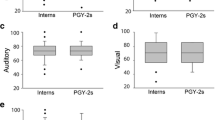Abstract
Background
Cardiac physical examination skills are often deficient in trainees and faculty members. Although recommended, the impact of cardiac physical examination faculty development on “downstream” trainee skills is unknown.
Aim
This study aims to evaluate the effectiveness of cardiac physical examination education for faculty and its impact on their students.
Methods
We developed an 8-h multimodality training course featuring deliberate practice and feedback. From July 2012 to April 2013, 17 internal medicine hospitalists were randomized to receive training. Impact was measured on hospitalists and 56 medical students. The primary outcome was hospitalist and student performance on a cardiac physical examination interpretation test.
Results
Intervention hospitalists significantly increased their cardiac physical examination interpretation skills from 54 % at pretest to 92 % at posttest (p < 0.001). However, test scores of students who worked with intervention hospitalists did not significantly increase (52 to 56 %, p = 0.26). Students rated the intervention hospitalists as more thorough on only one element of the cardiac physical examination than untrained faculty members (p = <0.05).
Conclusion
An 8-h faculty development course improved the cardiac physical examination skills of faculty. Skills of medical learners did not improve. Future faculty instruction needs to be more powerful or targeted directly to learners.



Similar content being viewed by others
References
Ramani S (2008) Twelve tips for excellent physical examination teaching. Med Teach 30:851–856
Anderson RC, Fagan MJ, Sebastian J (2001) Teaching students the art and science of physical diagnosis. Am J Med 110:419–423
Ramani S, Orlander JD, Strunin L, Barber TW (2003) Whither bedside teaching? A focus-group study of clinical teachers. Acad Med 78:384–390
Mangione S, Nieman LZ (1997) Cardiac auscultatory skills of internal medicine and family practice trainees. A comparison of diagnostic proficiency. JAMA 278:717–722
Mangione S, Nieman LZ, Gracely E, Kaye D (1993) The teaching and practice of cardiac auscultation during internal medicine and cardiology training. A nationwide survey. Ann Intern Med 119:47–54
Paauw DS, Wenrich MD, Curtis JR, Carline JD, Ramsey PG (1995) Ability of primary care physicians to recognize physical findings associated with HIV infection. JAMA 274:1380–1382
Vukanovic-Criley JM, Criley S, Warde CM et al (2006) Competency in cardiac examination skills in medical students, trainees, physicians, and faculty: a multicenter study. Arch Intern Med 166:610–616
Swing SR (2007) The ACGME outcome project: retrospective and prospective. Med Teach 29:648–654
Butter J, McGaghie WC, Cohen ER, Kaye M, Wayne DB (2010) Simulation-based mastery learning improves cardiac auscultation skills in medical students. J Gen Intern Med 25:780–785
Ericsson KA (2004) Deliberate practice and the acquisition and maintenance of expert performance in medicine and related domains. Acad Med 79:S70–S81
Fred HL, Grais IM (2010) Bedside skills: an exchange between dinosaurs. Tex Heart Inst J 37:205–207
Grais IM (2010) Bedside skills: a 50-year personal retrospective. Tex Heart Inst J 37:629–632
Miller AJ, Grais IM, Abrams DL, Kaplan BM, Shelton-Zoiopoulos LY (1999) Murmurs associated with mitral annular calcification and aortic sclerosis. Gerontology 45:115–119
Issenberg SB, McGaghie WC, Brown DD et al (2000) Development of multimedia computer-based measures of clinical skills in bedside cardiology. In: Melnick DE (ed) The eighth international Ottawa conference on medical education and assessment proceedings evolving assessment: protecting the human dimension. National Board of Medical Examiners, Philadelphia, pp 821–829
Bickley LS, Szilagyi PG, Bates B (2013) Bates’ guide to physical examination and history-taking, 11th edn. Wolters Kluwer Health/Lippincott Williams & Wilkins, Philadelphia
Issenberg SB, McGaghie WC, Gordon DL et al (2002) Effectiveness of a cardiology review course for internal medicine residents using simulation technology and deliberate practice. Teach Learn Med 14:223–228
Issenberg SB, Petrusa ER, McGaghie WC et al (1999) Effectiveness of a computer-based system to teach bedside cardiology. Acad Med 74:S93–S95
Crumlish CM, Yialamas MA, McMahon GT (2009) Quantification of bedside teaching by an academic hospitalist group. J Hosp Med 4:304–307
Stickrath C, Noble M, Prochazka A et al (2013) Attending rounds in the current era: what is and is not happening. JAMA Intern Med 173:1084–1089
Acknowledgments
We thank the Northwestern medical students who participated in this study for their dedication to patient care and education. We also thank Jay X. Thomas, PhD for his support of faculty development, and Anna-Kate Trubilowicz for her tireless efforts in data collection. We are indebted to Dr. Barry Issenberg for use of the computer-based UMedic curriculum and creation of the computer-based assessment tool. This study was supported by the Augusta Webster Grants for Innovation in Medical Education, Office of the Dean, Northwestern University Feinberg School of Medicine, Chicago, IL.
Conflict of Interest
Dr. McGaghie has been consultant to, and received honorariums from, the Gordon Center for Research in Medical Education at the University of Miami Miller School of Medicine. All other authors report no declarations of interest.
Author information
Authors and Affiliations
Corresponding author
Additional information
Notes on contributors
Eric W. Schaefer, MD is an Assistant Professor, of the Division of Hospital Medicine and Augusta Webster Office of Medical Education, Northwestern University Feinberg School of Medicine, Chicago, IL, USA. Diane B. Wayne, MD is the Dr. John Sherman Appleman Professor of Medicine at Northwestern University Feinberg School of Medicine, Chicago, IL, USA. William C Mcgaghie, PhD is the Director of the Ralph P. Leischner, Jr. MD Institute for Medical Education at Loyola University Stritch School of Medicine, Maywood, IL, USA. Sarah E Kozmic is a research coordinator, of the Northwestern University Feinberg School of Medicine, Chicago, IL, USA. I. Martin Grais, MD is an Associate Professor of Medicine, Division of Cardiology, Northwestern University Feinberg School of Medicine, Chicago, IL, USA. John Butter, MD is an Associate Professor of Medicine and Augusta Webster Office of Medical Education, Northwestern University Feinberg School of Medicine, Chicago, IL, USA.
Appendix A
Appendix A
Rights and permissions
About this article
Cite this article
Schaefer, E.W., Wayne, D.B., McGaghie, W.C. et al. Impact of Cardiac Physical Examination Faculty Development on Medical Student Performance: A Randomized Trial. Med.Sci.Educ. 24, 165–172 (2014). https://doi.org/10.1007/s40670-014-0031-4
Published:
Issue Date:
DOI: https://doi.org/10.1007/s40670-014-0031-4




